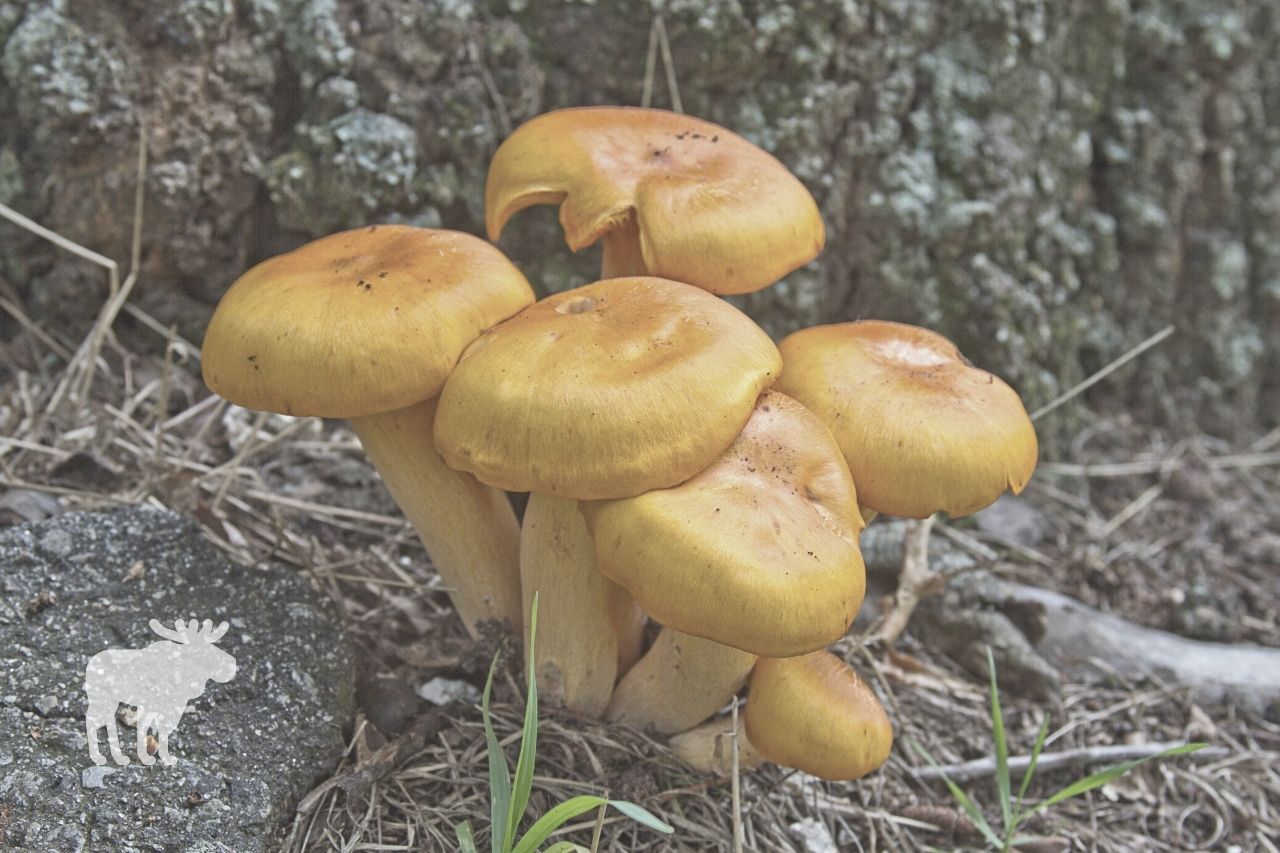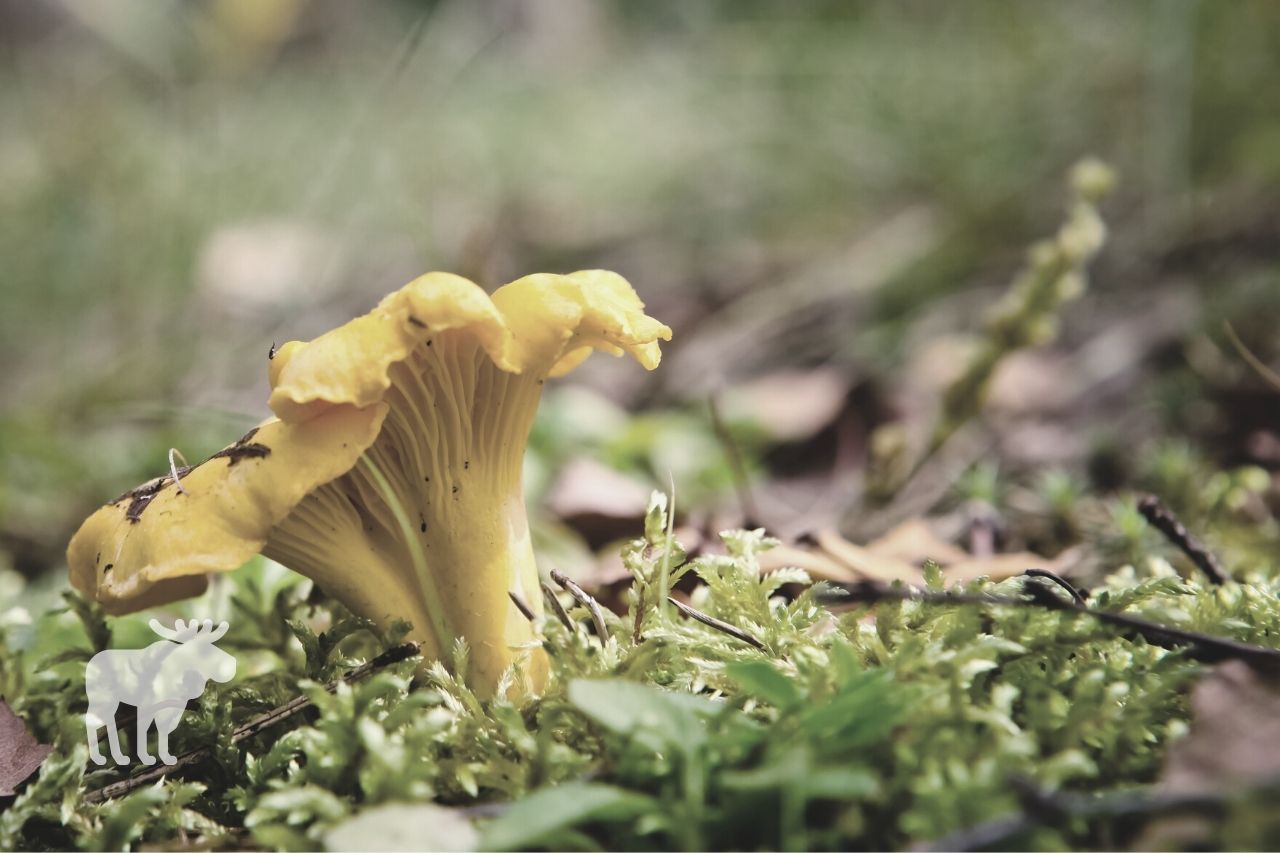In the world of mushroom foraging, proper identification is key. It can be the difference between enjoying a delicious meal and heading to the emergency room with severe digestive symptoms. Two mushrooms that are commonly confused are jack o’lanterns and chanterelles. In this article, we’ll compare the jack o’lantern mushroom vs. the chanterelle so you can learn which ones to harvest and which ones to avoid.
What You'll Learn Today
What is a Jack O’Lantern Mushroom?

Jack o’lantern mushrooms are found throughout much of the United States and in scattered regions of Europe.
These mushrooms grow primarily in hardwood forests, as they feed off dead and decaying wood. They can often be found growing at the base of dead trees or on fallen logs, though they sometimes appear to be growing out of the ground if the source wood is buried under dirt or forest debris.
Jack o’lanterns grow primarily in the summer and early fall, typically from July through October depending on region.
These mushrooms are bright orange-yellow in color. They have smooth, umbrella-shaped caps that often flatten out and become wavy as they age.
They have deep-set gills on the underside of the caps. Their stems are the same color as the caps, though they become darker and more narrow toward the base.
Sometimes young mushrooms will produce a faint green glow at night, as they are bioluminescent.
Jack o’lanterns tend to grow in large, tightly-packed clusters, though they can sometimes be found in smaller clusters or growing more spread out as well.
Jack o’lanterns are toxic; they are not considered deadly to the average healthy adult, but they can cause several days of digestive upset.
What is a Chanterelle?

Chanterelle mushrooms are widely distributed throughout North America, Europe, Asia, and Africa.
Chanterelles, like jack o’lanterns, are commonly found in hardwood forests. Unlike jack o’lanterns, they don’t grow from dead and decaying wood; rather, they have a symbiotic relationship with the roots of living trees, so they are typically found growing on the ground several feet from the base of trees.
Chanterelles grow throughout early summer into early fall. They can be found anytime between May and October in many regions.
Chanterelles can come in many different bright colors, including yellow, orange, red, blue, white, and black. The yellow chanterelles are most common in most areas.
Chanterelle mushrooms have wavy, funnel-shaped caps. They don’t have gills, though many varieties have stiff, gill-like ridges running from the underside of the cap down the stem.
They are solid and white inside and can be pulled apart easily. They tend to come apart in much the same way as a stick of string cheese does.
Chanterelles may grow in clusters of three to six mushrooms, but they tend to grow more scattered on the forest floor.
Chanterelles are edible and delicious, with a unique flavor that is mildly sweet and peppery. They are widely sought after by gourmet chefs and mushroom lovers throughout the world and can be identified by their fruity, apricot-like aroma.
Jack O’Lantern Vs. Chanterelle: Similarities and Differences
On paper, these two types of mushrooms may appear quite different, but they are often confused by novice foragers. And, considering jack o’lanterns are toxic and chanterelles are edible, these are two mushrooms you don’t want to confuse.
Let’s take a closer look at some of their similarities and differences.
Similarities
- Habitat: Both jack o’lanterns and chanterelles can be found growing in the same kind of habitat, though chanterelles are more widely distributed throughout the world. Both kinds of mushrooms grow in relation to hardwood trees.
- Growing season: Jack o’lanterns and chanterelles have the same growing season–both mushroom types grow in summer and early fall. They can commonly be found after a period of rain during this season.
- Coloring: Chanterelles and jack o’lanterns are most commonly confused because of their similarity in coloring. Many chanterelles are bright yellow to orange in color, while jack o’lanterns are typically a smooth, almost shiny, bright yellowish-orange.
Differences
- Scientific families: These two mushrooms are completely different species. The jack o’lantern is known scientifically as Omphalotus illudens and belongs to the Omphalotaceae family; chanterelles belong to several genera in the Cantharellaceae family.
- Edibility: The most important difference between these two mushrooms is that jack o’lanterns are poisonous while chanterelles are edible. Since chanterelles are such a popular and tasty mushroom, it’s extremely important to be able to distinguish them from jack o’lanterns.
- Cluster sizes: Jack o’lanterns typically grow in much larger and more tightly-packed clusters than chanterelles. Chanterelles do tend to grow in clusters, but they are typically small clusters of only a few mushrooms, and they tend to be more spread out than jack o’lanterns.
- Cap shape: Generally speaking, jack o’lanterns have more smooth, round, shiny caps while chanterelles have more wavy, funnel-shaped caps. That said, jack o’lantern caps may become more wavy and funnel-shaped as they age.
- Growth: Jack o’lanterns grow directly from dead and decaying wood, though the wood is sometimes not visible because it may be buried under layers of forest debris. Chanterelles don’t grow from wood; instead, they grow from the ground near trees, as they have a symbiotic relationship with the tree roots.
Jack O’Lantern Vs. Chanterelle: How to Tell Them Apart
Suppose you’re out mushroom hunting in summer and you come across a brightly colored patch of mushrooms. How can you be certain to correctly identify them?
It might help to watch a video like the one below to get a visual comparison of jack o’lanterns and chanterelles.
That said, never eat any mushrooms unless you are certain that they have been correctly identified. If you’re new to mushroom hunting, go with someone who is more experienced and learn from them until you are comfortable with your own mushroom identification skills.
Let’s talk about some things you might look for to help you tell apart chanterelles and jack o’lanterns.
- Observe the color: Jack o’lanterns are typically a bright, shiny orange-yellow, while chanterelles are more distinctly yellow or orange. Jack o’lantern caps will be smooth as though they have been shined and waxed, while chanterelle caps may appear more drab and rough.
- Find what it’s growing from: If you observe a cluster of growing mushrooms, dig down around their base to discover if they are growing from rotting wood. If they are growing from the ground and there is no rotting wood attached to them, then they are most likely chanterelles instead of jack o’lanterns.
- Check the cap underside: Jack o’lantern mushrooms have deep, fleshy gills that can be broken off if you rub them. Chanterelles are either smooth on the underside or will have flat, stiff ridges that cannot be rubbed away.
- Smell the mushroom: Jack o’lanterns don’t have a distinct aroma; they are most often described simply as smelling “mushroomy.” On the other hand, chanterelles will have a sweet, fruity smell that is often compared to fresh apricots.
- Do a spore print test: Jack o’lantern mushrooms have white to cream-colored spores, while chanterelle mushrooms have more pinkish-colored spores.
Conclusion
Edible chanterelle mushrooms are often mistaken for toxic jack o’lantern mushrooms, and this is one mistake you never want to make. Fortunately, there are many different ways to distinguish the two types of mushrooms, and as long as you take the time to learn their differences, you should have no trouble telling them apart.
“Check the cap underside: Jack o’lantern mushrooms have deep, fleshy gills that can be broken off if you rub them. Chanterelles are either smooth on the underside or will have flat, stiff ridges that cannot be rubbed away.”
This is OPPOSITE to what the video says (6:35) – this needs to be cleared up as it could potentially kill someone.
Thank you for your attention to this.
Thanks Justin, I’ve replaced the video with a new one which I think explains it better.